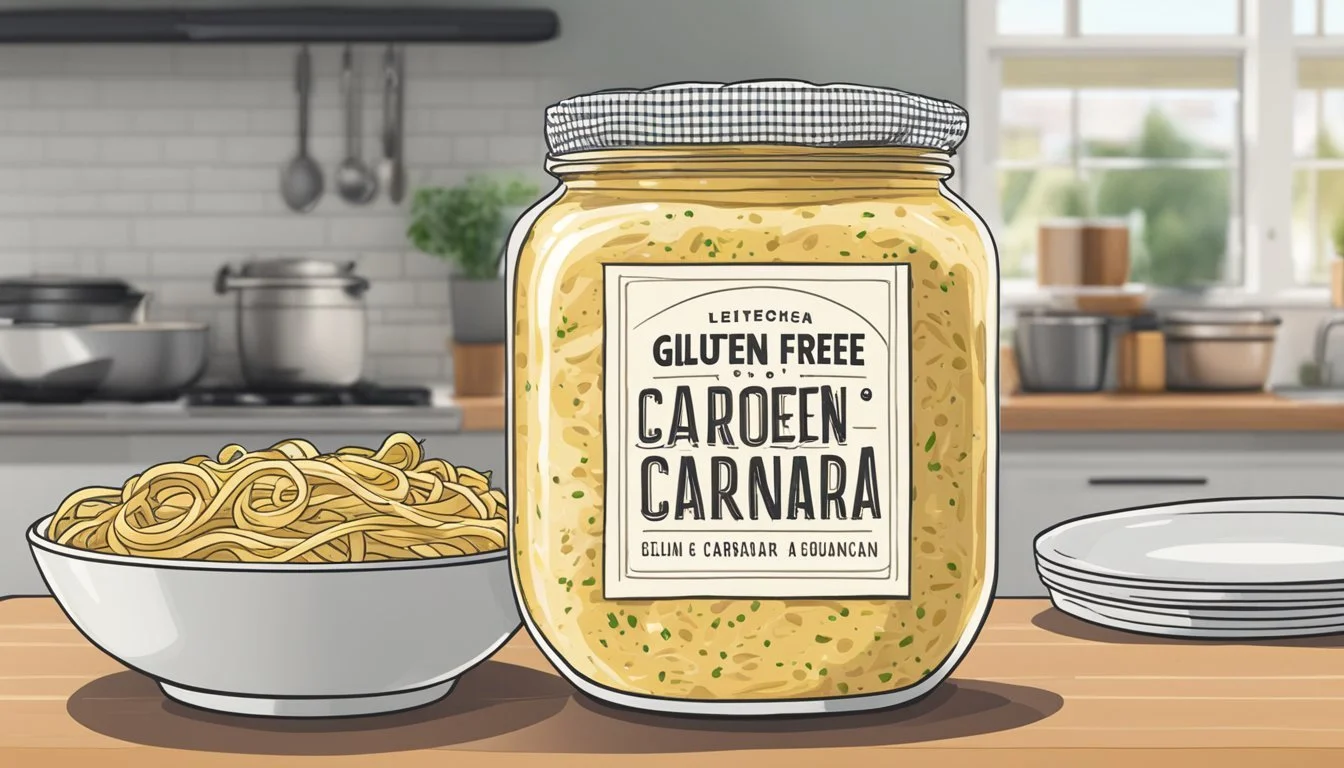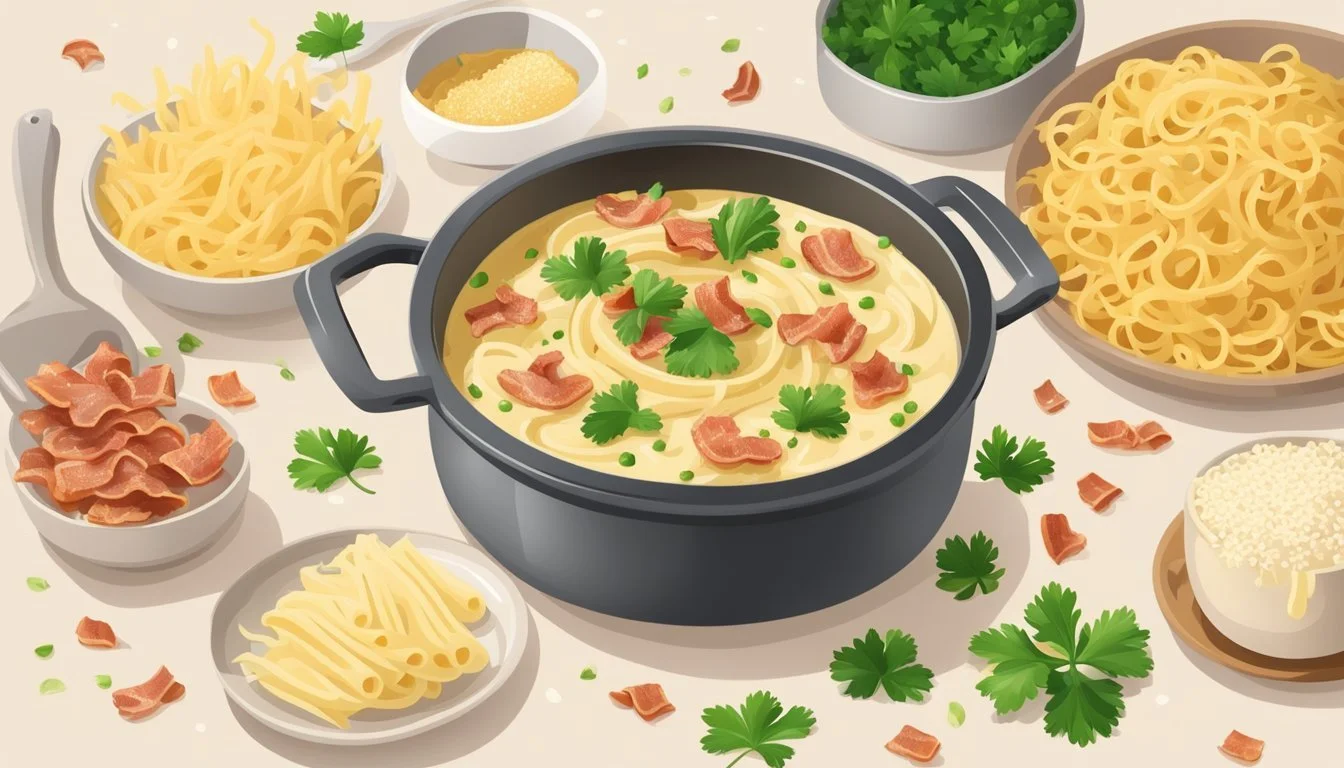Is Carbonara Sauce Gluten-Free?
Unveiling the Truth About This Classic Italian Dish
Carbonara sauce often raises questions among those who follow a gluten-free diet. Traditional carbonara sauce, an Italian staple known for its creamy texture and savory flavor, is a simple concoction of eggs, cheese (Pecorino Romano or Parmigiano-Reggiano), pancetta, and black pepper. This sauce does not contain gluten in its pure form, as it does not require flour or other gluten-containing thickeners.
However, carbonara is typically served over pasta (What wine goes well with pasta?), which is ordinarily made from wheat that contains gluten. For the entire dish to be gluten-free, it must be paired with gluten-free pasta, which can be made from corn, rice, quinoa, or other gluten-free grains. Care should also be taken to avoid cross-contamination with gluten-containing ingredients during preparation, which is a common pitfall in both home and restaurant kitchens.
What Is Carbonara Sauce?
Carbonara sauce is a classic Italian condiment that epitomizes the rich and comforting essence of authentic Italian comfort food. This creamy sauce is traditionally made with a few fundamental ingredients that combine to create a delectably smooth and savory taste.
Ingredients typically used in Carbonara Sauce:
Pasta: Often spaghetti, though other pastas can be used.
Bacon: Typically, pancetta or guanciale is the preferred choice for an authentic Italian carbonara.
Cheese: Pecorino Romano and/or Parmesan cheese add depth and a salty flavor.
Eggs: Whole eggs, or a combination of whole eggs and yolks, bind the sauce and create a creamy texture.
Black Pepper: Freshly cracked for a warm, spicy note.
The essence of carbonara lies in its simplicity. The process involves cooking the pasta until al dente while simultaneously rendering the bacon to release its rich, smoky flavors. The eggs, beaten with cheese and fresh black pepper, are then combined with the cooked pasta, using the residual heat to gently thicken the sauce without scrambling the eggs.
It's important to note that traditional carbonara sauce does not contain cream, as the use of dairy other than cheese is not authentic. While rich and creamy in flavor, the silky texture of carbonara is the result of the eggs and cheese melding with the heat of the pasta.
As for gluten content, the sauce itself is gluten-free; however, carbonara is typically served with pasta which often contains gluten. To make the dish gluten-free, one would need to opt for gluten-free pasta. The beauty of carbonara sauce is its versatility—it can be enjoyed with any variety of pasta while still maintaining its integrity as a beloved Italian dish.
Ingredients of Traditional Carbonara
Traditional Carbonara is a testament to simplicity and quality, where each component plays a vital role in creating a dish that's greater than the sum of its parts.
Pasta and Its Role in Carbonara
In traditional Carbonara, spaghetti is typically used and is fundamental, serving as the base for the sauce. The choice of pasta affects the texture and the dish's ability to hold the sauce, with spaghetti being the classic choice for its ideal surface and thickness.
The Significance of Eggs and Dairy
The creamy texture in Carbonara comes from eggs, specifically a mixture of whole eggs and additional yolks. Pecorino Romano and Parmesan cheeses are the dairy components, adding depth and a salty, umami flavor. Their quality directly impacts the richness and authenticity of the sauce.
Choosing the Right Meat: Guanciale, Pancetta, or Bacon
The meat enhances Carbonara with a savory, smoky flavor. Guanciale (cured pork cheek) is traditional and imparts a distinct richness. Pancetta, another Italian cured meat, is an acceptable substitute, while bacon can be used for its smoky profile but deviates from the original taste and texture.
Seasoning: Salt, Pepper, and Cheese
Proper seasoning is crucial. Sea salt is used to flavor the pasta water and the dish, while freshly cracked black pepper adds a subtle heat and pairs perfectly with the fatty richness of the meat and the sharpness of the cheese. The cheese itself—Pecorino Romano and Parmesan—also provides a level of salty tang to the dish.
Understanding Gluten
In this section, the reader will learn what gluten is and the typical sources of gluten found in pasta dishes (What wine goes well with pasta dishes?), including how these might affect those with gluten sensitivities.
What Is Gluten?
Gluten is a family of proteins predominantly present in wheat, barley, and rye. It's known for giving dough its elastic texture and is often a key structural component in pasta. Gluten can trigger adverse reactions in individuals with celiac disease or non-celiac gluten sensitivity.
Sources of Gluten in Pasta Dishes
When it comes to pasta dishes like carbonara, the primary source of gluten comes from the pasta itself. Traditional spaghetti pasta is made from wheat and therefore contains gluten. Here are common and alternative pasta types:
Common sources of gluten in pasta:
Whole wheat pasta: Made from whole wheat flour, it contains all gluten-containing parts of the grain.
Spaghetti and other pasta shapes typically made from wheat.
Gluten-free alternatives:
Gluten-free pasta: Can be made from brown rice, rice pasta, or other gluten-free flours.
Specific brands like Jovial offer gluten-free pasta options that are suitable for gluten-sensitive individuals.
By choosing gluten-free pasta made from non-gluten grains, individuals with gluten-related disorders can enjoy a pasta dish like carbonara without concerns over gluten.
Making Carbonara Gluten-Free
When adapting carbonara to be gluten-free, focusing on pasta selection, ingredient purity, and appropriate seasonings ensures that the integrity of this classic dish remains intact without compromising on taste or texture.
Selecting Gluten-Free Pasta Varieties
To ensure carbonara is gluten-free, one must choose from the diverse range of pasta alternatives. Gluten-free spaghetti options include those made from brown rice, quinoa, corn, or a blend of gluten-free grains. Brown rice spaghetti is particularly popular for its texture that closely mirrors traditional pasta. Below is a simple guide for cooking gluten-free pasta:
Large Pot: Use a large pot filled with plenty of boiling water to prevent sticking.
Cooking Time: Follow the package directions as gluten-free pasta typically has a different cooking time than wheat pasta.
Al Dente: Aim for an 'al dente' texture, as overcooked gluten-free pasta can become mushy.
Gluten-Free Dairy and Meat Considerations
For a gluten-free carbonara, it’s crucial to verify that all meat and dairy components are gluten-free. Traditional carbonara typically includes pancetta or bacon. Choose options that are labeled gluten-free as some meat products can be cross-contaminated or contain gluten-based additives.
Select cheese that is pure and has no gluten-containing fillers. Often, freshly grated Parmesan is a safe bet. Here's what to look for:
Meat: Check labels for a gluten-free certification.
Cheese: Opt for natural, unprocessed cheeses.
Adjusting Seasonings for Gluten-Free Diets
Seasonings in a carbonara sauce can seem straightforward but watch for hidden gluten in products like pre-ground black pepper or store-bought cheese that might use gluten as an anti-caking agent. Use fresh ingredients to control for gluten contamination. Keep seasonings simple:
Black Pepper: Freshly grind peppercorns to avoid additives.
Salt: Use pure, uniodized salt to taste.
Cooking Gluten-Free Carbonara
When making gluten-free carbonara, one should ensure the absence of gluten in pasta and any additional ingredients, while also focusing on achieving the creamy texture that characterizes this classic Italian dish. It is a relatively easy course to make, often requiring a simple set of kitchen tools and staple ingredients.
Kitchen Equipment Needed
To prepare gluten-free carbonara, the following kitchen equipment is essential:
Large skillet: Necessary for rendering the fat from pancetta or bacon and sautéing additional ingredients.
Mixing bowl: Used for preparing the egg and cheese mixture.
Whisk: A crucial tool for mixing ingredients to create a smooth sauce.
Pot: Required for boiling the pasta.
Preparation: Mixing and Whisking Techniques
The preparation begins with the following steps:
Whisking Eggs: Combine whole eggs and additional yolks in a mixing bowl and whisk thoroughly.
Cheese: Grate the chosen cheese, typically Parmesan or Pecorino Romano, and whisk it into the eggs.
Seasoning: Incorporate black pepper for an authentic flavor and whisk the mixture to ensure even distribution.
Recipe and Cook Time
A standard gluten-free carbonara recipe includes these steps:
Cook gluten-free pasta as per package instructions; the prep time and cook time will vary depending on the brand.
In a large skillet, cook pancetta or bacon until crisp; this usually takes about 4-5 minutes.
Reserve a small amount of pasta water before draining the pasta, which can be used to adjust the sauce's consistency later.
Total Time: From preparation to cooking, the whole process takes approximately 20-30 minutes.
Finalizing the Dish: Texture and Creaminess
The final stages are crucial for achieving the desired creamy texture:
Pour the egg and cheese mixture onto the hot pasta, using the residual heat to cook the eggs without scrambling them.
Add a bit of the reserved pasta water if the mixture is too thick. Properly done, the sauce should coat the pasta evenly, resulting in a creamy but not overly wet texture.
Serve immediately to enjoy the best quality of texture and flavor.
By following these instructions, one can prepare gluten-free carbonara that maintains the traditional aspects of the dish albeit suitable for those adhering to a gluten-free diet.
Serving Suggestions
When serving gluten-free carbonara sauce, it enhances the overall experience to pair it with complementary sides, select the right wine, and attend to the presentation details with a few garnishes.
Complementing Salads and Sides
Pairing a gluten-free carbonara with fresh salads or vegetable sides adds balance to the richness of the sauce. A simple salad with a mix of greens tossed in a light vinaigrette works well. For sides, consider steamed or sautéed peas as they pair nicely with the creamy texture of carbonara. Garlic bread made from gluten-free bread can also accompany the dish for those who wish to indulge in the classic pairing while maintaining a gluten-free diet.
Appropriate Wine Pairings
Selecting a wine to complement gluten-free carbonara is crucial for completing the culinary experience. A red wine with a good balance of acid, such as a Pinot Noir, harmonizes with the creamy sauce without overpowering it. If one prefers white wines, a Chardonnay with its buttery notes can be an excellent match.
Wine Pairings:
Red wine: Pinot Noir
White wine: Chardonnay
Presentation and Garnishing
The final touch to serving carbonara is in the presentation and garnish. A sprinkle of grated parmesan cheese adds an authentic Italian touch and extra flavor. Fresh parsley not only adds a pop of color but also a fresh flavor contrast. For a final flourish, a touch of freshly cracked black pepper ranges both for taste and visual appeal. These small details elevate the dish and enhance the dining experience.
Storing Leftover Carbonara
When handling leftover Carbonara, proper storage is key to maintaining its quality. Leftovers should be placed in an airtight container to prevent the sauce from absorbing unwanted flavors from the refrigerator and to keep it fresh. This also helps in avoiding the sauce from drying out.
One must transfer the Carbonara into the container as soon as it has cooled to room temperature, typically within two hours of cooking to prevent bacterial growth. They should ensure that the container is sealed tightly before placing it in the refrigerator.
For reheating, the ideal approach is using the stovetop over gentle heat. They should add a little water or cream to the pan to loosen up the sauce, as it tends to thicken in the fridge. Continual stirring will help in achieving an even temperature and prevent the eggs in the sauce from scrambling. Reheating in the microwave is also an option, albeit one should do it in short bursts and stir in between to ensure even warmth.
Leftover Carbonara can be refrigerated for up to three days. Beyond this period, it is advisable not to consume the sauce, as the quality will have degraded significantly, and there is a potential risk of foodborne illness.
Storing: Immediately in an airtight container
Refrigerator: Up to 3 days
Reheating: Stovetop preferred, microwave in short intervals
Adhering to these guidelines will help one enjoy their Carbonara leftovers while ensuring the dish remains safe to eat and as delicious as when it was first prepared.
Nutrition and Dietary Considerations
When considering the nutrition and dietary aspects of carbonara sauce, it's important to examine the caloric content and the potential for dairy-free and vegan alternatives. This examination ensures that those adhering to specific dietary requirements can understand how carbonara fits into their eating plan.
Caloric Content of Carbonara
Carbonara sauce is typically rich in calories due to its traditional ingredients, which include eggs, cheese, and pork. An average serving of carbonara sauce can contain upwards of 400 calories, mainly from fats and proteins. It's essential for individuals monitoring their caloric intake to be mindful of portion sizes when enjoying this comfort food.
Ingredients contributing to caloric content:
Eggs
Cheese (Pecorino Romano and Parmesan)
Bacon or pancetta
Dairy-Free and Vegan Alternatives
For those looking for dairy-free or vegan options, several substitutions can be made to the traditional carbonara recipe without sacrificing the creamy texture and savory flavor.
Dairy-free alternatives:
Nutritional yeast can replace cheese for a similar umami flavor.
Coconut cream or unsweetened non-dairy milk can serve as a base for the sauce.
Vegan alternatives:
Vegan bacon made from plant-based ingredients like tempeh can substitute for traditional pork.
Egg replacements such as mashed bananas or silken tofu can be used to achieve the sauce's consistency.
These modifications not only reduce the dairy content but also generally lower the overall calorie count of the dish, making it more suitable for vegan diets and those with dairy sensitivities. To maintain organic integrity, individuals may opt for organic versions of these substitutes.
Exploring Carbonara Variations
Carbonara sauce, traditionally made with eggs, cheese, pancetta, and pepper, is a staple of Italian cuisine known for its creamy texture and smoky flavor. Variations of the classic spaghetti carbonara offer a vast array of flavors and ingredients to accommodate different dietary preferences and available pantry staples.
Veggie and Protein Variations
When it comes to varying the protein in a carbonara recipe, chefs might choose to substitute pancetta with options like turkey bacon or mushroom for a vegetarian twist. They often consider the fat content and flavor profile to maintain the balance that carbonara sauce is known for. Incorporating vegetables can provide a nutritional boost as well as vibrant colors. Options like asparagus, peas, or spinach are common.
Proteins:
Traditional: Pancetta or guanciale
Alternative: Turkey bacon, mushrooms (for a vegetarian variant)
Vegetables:
Common Additions: Asparagus, peas, spinach
Sauce and Cream Additions
Traditional carbonara does not include cream; however, many modern recipes introduce cream or milk to add richness. The key lies in the technique of emulsifying the pasta water with the cheese to create a creamy sauce without heaviness. Considerations for sauce variations might include a drizzle of olive oil for a silkier texture, or the addition of garlic cloves for depth of flavor. These additions can transform the dish while keeping it within the realm of familiar pantry staples.
Creaminess Enhancers:
Non-Traditional: Cream, milk
Emulsifying Agent: Pasta water
Flavor Enhancements:
Olive oil (for texture)
Garlic cloves (for flavor depth)
Conclusion
Traditional carbonara sauce is not inherently gluten-free due to its reliance on pasta which usually contains gluten. However, individuals seeking a gluten-free dinner option can modify the recipe to meet their dietary needs. For a successful gluten-free carbonara, one should use gluten-free pasta and confirm that all other ingredients, such as cheese and pancetta, are free from gluten contaminants.
The essence of carbonara lies in its simple yet rich combination of egg, cheese, pancetta or bacon, and pepper. The use of gluten-free pasta offers an alternative that accommodates those with celiac disease or gluten sensitivity without compromising on taste.
When preparing a gluten-free carbonara, to avoid cross-contamination, one should use separate cooking utensils and surfaces specifically designated for gluten-free cooking.
Key Ingredients Gluten-Free Consideration Pasta Use certified gluten-free pasta Eggs Naturally gluten-free Cheese Check for gluten-free label Pancetta/Bacon Ensure no gluten in additives
To conclude, a gluten-free carbonara is a feasible and delicious alternative for a classic dinner dish. It requires careful selection of gluten-free ingredients and attention to cooking methods to ensure the final meal is safe for those with dietary restrictions. With these precautions in place, everyone can enjoy the rich and creamy flavors of carbonara sauce without gluten-related concerns.









